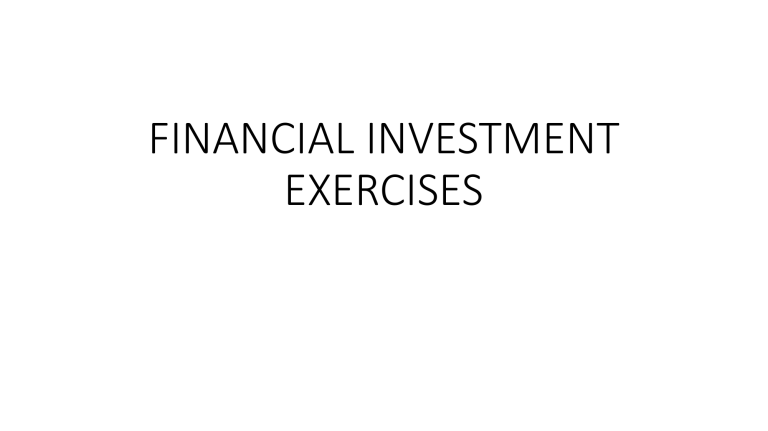
FINANCIAL INVESTMENT EXERCISES INDEXES – EXE1 • Imagine that the Mini-Dow Average (MDA) is based on the closing prices of five stocks. The divisor used in the calculation of the MDA is currently 0.765. The closing prices for each of the five stocks in the MDA today and exactly one year ago, when the divisor was 0.780, are given in the accompanying table. a. Calculate the MDA today and that of a year ago. b. Compare the values of the MDA calculated in part a and describe the apparent market behavior over the last year. Was it a bull or a bear market? INDEXES – EXE2 • The SP-6 Index (a fictitious index) is used by many investors to monitor the general behavior of the stock market. It has a base value set equal to 100 at January 1, 1978. In the accompanying table, the closing market values for each of the six stocks included in the index are given for three dates. a. Calculate the value of the SP-6 index on both January 1, 2016, and June 30, 2016, using the data presented here. b. Compare the values of the SP-6 Index calculated in part a and relate them to the base index value. Would you describe the general market condition during the 6-month period January 1 to June 30, 2016, as a bull or a bear market? INDEXES – EXE3 • Deepa Chungi wishes to develop an average, or index, that can be used to measure the general behavior of stock prices over time. She has decided to include six closely followed, high-quality stocks in the average or index. She plans to use August 15, 1987, her birthday, as the base and is interested in measuring the value of the average or index on August 15, 2013, and August 15, 2016. She has found the closing prices for each of the six stocks, A through F, at each of the three dates and has calculated a divisor that can be used to adjust for any stock splits, company changes, and so on that have occurred since the base year, which has a divisor equal to 1.00. • a. Using the data given in the table, calculate the market average, using the same methodology used to calculate the Dow averages, at each of the dates—August 15, 1987, 2013, and 2016. • b. Using the data given in the table and assuming a base index value of 10 on August 15, 1987, calculate the market index, using the same methodology used to calculate the S&P indexes, at each of the dates. • c.Use your findings in parts a and b to describe the general market condition—bull or bear—that existed between August 15, 2013, and August 15, 2016. • d. Calculate the percentage changes in the average and index values between August 15, 2013, and August 15, 2016. Why do they differ? INDEXES – EXE3 Margin trading – EXE1 • Marlene Bellamy purchased 300 shares of Writeline Communications stock at $55 per share using the prevailing minimum initial margin requirement of 50%. She held the stock for exactly four months and sold it without brokerage costs at the end of that period. During the 4-month holding period, the stock paid $1.50 per share in cash dividends. Marlene was charged 9% annual interest on the margin loan. The minimum maintenance margin was 25%. • a. Calculate the initial value of the transaction, the debit balance, and the equity position on Marlene’s transaction. • b. For each of the following share prices, calculate the actual margin percentage, and indicate whether Marlene’s margin account would have excess equity, would be restricted, or would be subject to a margin call. 1. $45 2. $70 3. $35 • c. Calculate the dollar amount of (1) dividends received and (2) interest paid on the margin loan during the 4-month holding period. • d. Use each of the following sale prices at the end of the 4-month holding period to calculate Marlene’s annualized rate of return on the Writeline Communications stock transaction. 1. $50 2. $60 3. $70 Fixed – income sec. – EXE1 • A certain 6% annual coupon rate convertible bond (maturing in 20 years) is convertible at the holder’s option into 20 shares of common stock. The bond is currently trading at $800. The stock (which pays 75¢ a share in annual dividends) is currently priced in the market at $35 a share. a. What is the bond’s conversion price? b. What is its conversion ratio? c. What is the conversion value of this issue? What is its conversion parity? d. What is the conversion premium, in dollars and as a percentage? e. What is the bond’s payback period? f. If comparably rated nonconvertible bonds sell to yield 8%, what is the investment value of the convertible? Fixed – income sec. – EXE2 • You are considering investing $800 in Higgs B. Technology Inc. You can buy common stock at $25 per share; this stock pays no dividends. You can also buy a convertible bond ($1,000 par value) that is currently trading at $790 and has a conversion ratio of 30. It pays $40 per year in interest. If you expect the price of the stock to rise to $33 per share in one year, which instrument should you purchase? Basics of common stock – EXE1 Total assets Total debt Preferred stock Common stockholders’ equity Net profits after taxes Number of preferred stock outstanding Number of common stock outstanding Preferred dividends paid Common dividends paid Market price of the preferred stock Market price of the common stock $240 million $115 million $ 25 million $100 million $22.5 million 1 million shares 10 million shares $2 per share $0.75 per share $30.75 per share $25.00 per share • Use the information above to find the following. a. The company’s book value b. Its book value per share c. The stock’s earnings per share (EPS) d. The dividend payout ratio e. The dividend yield on the common stock f. The dividend yield on the preferred stock Basics of common stock – EXE1 • Use the information above to find the following. a. The company’s book value b. Its book value per share c. The stock’s earnings per share (EPS) d. The dividend payout ratio e. The dividend yield on the common stock f. The dividend yield on the preferred stock Stock valuation – EXE1 • HighTeck has an ROE of 15%. Its earnings per share are $2.00, and its dividends per share are $0.20. Estimate HighTeck’s growth rate. Stock valuation – EXE2 • Melissa Popp is thinking about buying some shares of R. H. Lawncare Equipment, at $48 per share. She expects the price of the stock to rise to $60 over the next three years. During that time she also expects to receive annual dividends of $4 per share. • a. What is the intrinsic worth of this stock, given a 12% required rate of return? • b. What is its expected return? Stock valuation – EXE3 • Larry and Curley are brothers. They’re both serious investors, but they have different approaches to valuing stocks. Larry, the older brother, likes to use the dividend valuation model. Curley prefers the free cash flow to equity valuation model. As it turns out, right now, both of them are looking at the same stock— American Home Care Products, Inc. (AHCP). The company has been listed on the NYSE for over 50 years and is widely regarded as a mature, rock-solid, dividendpaying stock. The brothers have gathered the following information about AHCP’s stock: • Current dividend (D0) = $2.50/share Current free cash flow (FCF0) = $1 million • Expected growth rate of dividends and cash flows (g) = 5.0% Required rate of return (r) = 12.0% Shares outstanding = 400,000 How would Larry and Curley each value this stock? Stock valuation – EXE4 • Assume you’ve generated the following information about the stock of Bufford’s Burger Barns: • • • • • The company’s latest dividends of $4 a share are expected to grow to $4.32 next year, to $4.67 the year after that, and to $5.04 in three years. After that, you think dividends will grow at a constant 6% rate. a. Use the variable growth version of the dividend valuation model and a required return of 15% to find the value of the stock. b. Suppose you plan to hold the stock for three years, selling it immediately after receiving the $5.04 dividend. What is the stock’s expected selling price at that time? As in part (a), assume a required return of 15%. c. Imagine that you buy the stock today paying a price equal to the value that you calculated in part (a). You hold the stock for three years, receiving the dividends as described above. Immediately after receiving the third dividend, you sell the stock at the price calculated in part b. Use the IRR approach to calculate the expected return on the stock over three years. Could you have guessed what the answer would be before doing the calculation? d. Suppose the stock’s current market price is actually $44.65. Based on your analysis from part a, is the stock overvalued or undervalued? e. A friend of yours agrees with your projections of Bufford’s future dividends, but he believes that in three years, just after the company pays the $5.04 dividend, the stock will be selling in the market for $53.42. Given that belief, along with the stock’s current market price from part d, calculate the return that your friend expects to earn on this stock over the next three years. Stock valuation – EXE5 • Consolidated Software doesn’t currently pay any dividends but is expected to start doing so in four years. That is, Consolidated will go three more years without paying dividends and then is expected to pay its first dividend (of $3 per share) in the fourth year. Once the company starts paying dividends, it’s expected to continue to do so. The company is expected to have a dividend payout ratio of 40% and to maintain a return on equity of 20%. Based on the DVM, and given a required rate of return of 15%, what is the maximum price you should be willing to pay for this stock today? Stock valuation – EXE6 • You’re thinking about buying some stock in Affiliated Computer Corporation and want to use the P/E approach to value the shares. You’ve estimated that next year’s earnings should come in at about $4.00 a share. In addition, although the stock normally trades at a relative P/E of 1.15 times the market, you believe that the relative P/E will rise to 1.25, whereas the market P/E should be around 18.5 times earnings. Given this information, what is the maximum price you should be willing to pay for this stock? If you buy this stock today at $87.50, what rate of return will you earn over the next 12 months if the price of the stock rises to $110.00 by the end of the year? (Assume that the stock doesn’t pay dividends.)






